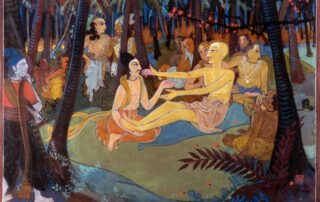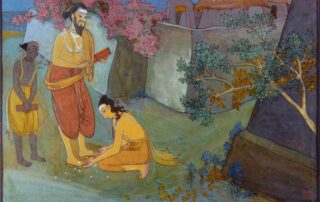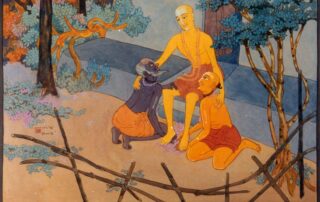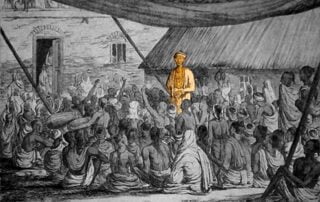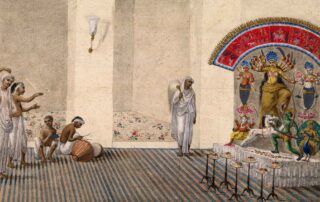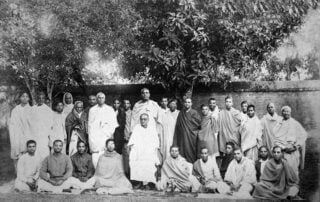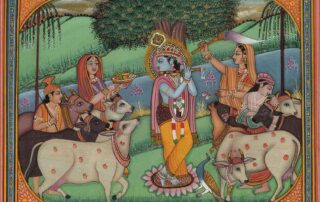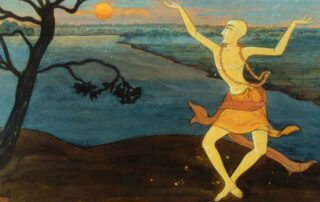Articles by Śrīla Bhaktivinoda Ṭhākura
Discover the profound wisdom of Śrīla Bhaktivinoda Ṭhākura, through our vast collection of his written articles that explore various aspects of Gauḍiya Vaiṣṇavism. Gain valuable insights into the path of bhakti-yoga as you delve into the teachings of this celebrated vaiṣṇava luminary. Our user-friendly interface makes it easy to access and explore the works of Bhaktivinoda Ṭhākura by topic.
Articles by Śrīla Bhaktivinoda Ṭhākura
Discover the profound wisdom of Śrīla Bhaktivinoda Ṭhākura, through our vast collection of his written articles that explore various aspects of Gauḍiya Vaiṣṇavism. Gain valuable insights into the path of bhakti-yoga as you delve into the teachings of this celebrated vaiṣṇava luminary. Our user-friendly interface makes it easy to access and explore the works of Bhaktivinoda Ṭhākura by topic.
Atyāhāra (Overeating or collecting too much)
This article "Atyāhāra (Overeating or collecting too much)" is the first of a series of articles published in the 10th Volume of Sajjana Toṣaṇī which deals with the six things that are favourable to bhakti and the six things that are unfavourable according to the second and third verses of Śrīla Rūpa Gosvāmī’s Upadeśāmṛta. This first article deals with atyāhara - overeating or collecting too much.
Vaiṣṇava Sevā (Service to the Devotees)
"Vaiṣṇava Sevā (Service to the Devotees)" was first published in the 7th Volume of Sajjana Toṣaṇī in 1894, wherein the Thākura stresses the importance of serving the Vaiṣṇavas, but also explains what real service and so-called ‘service’ is.
Śrī Guru Bhakti (Devotion to Śrī Guru)
In "Śrī Guru Bhakti (Devotion to Śrī Guru)" from the 11th Volume of Sajjana Toṣaṇi, Śrīla Bhaktivinoda Ṭhākura explains details on guru-tattva, the necessity for the jīva to accept a guru, and serving the guru with devotion, care and determination.
Sādhana
Bhaktivinoda Ṭhākura writes about how the process of sādhana is necessary for increasing one’s thirst to attain the Supreme, in this article first published in 1899, in the 11th Volume of Sajjana Toṣaṇī.
Sad-guṇa and Bhakti
Sad-guṇa and Bhakti was first published in 1893, in Volume 5 of Sajjana Toṣaṇī, this article describes the many auspicious qualities found in the personality of a Vaiṣṇava, and Bhaktivinoda Ṭhākura points out how all such qualities naturally appear wherever bhakti is found.
Pratiṣṭhāśa Parivarjana (Desire for Name and Fame)
In this article "Pratiṣṭhāśa Parivarjana (Desire for Name and Fame)" from 1896, first published in the 8th Volume of Sajjana Toṣaṇī, Bhaktivinoda Ṭhākura describes the dangers of pratiṣṭḥāśā (the desire for name and fame) and the necessity for all serious sādhakas to uproot this tendency.
On Durga Siva and Kali in Their Exoteric Aspects: A Criticism on Max Muller
This English article "On Durga, Siva and Kali in Their Exoteric Aspects: A Criticism on Max Muller" appeared in three parts in The Dawn, Vol.2. No. 5, 6 and 8, September/October/December, 1901. This was a revised and shorter version of the Ṭhākura’s earlier essay entitled ‘The Hindu Idols’ that he wrote in response to the Anti-Hindu article published in the magazine of the Christian Tract Society in 1899. It would seem that this article was discontinued in The Dawn.
The Society of Śrī Gaurāṅga (Śrī Gaurāṅga Samāja)
In this article "Śrī Gaurāṅga Samāja (The Society of Śrī Gaurāṅga)" from the 10th volume of Sajjana Toṣaṇī, Bhaktivinoda Ṭhākura deliberates upon what is the actual society of Śrī Gaurāṅga and explains the true meaning of iṣṭa-goṣṭhi according to Śrī Caitanya-caritāmṛta.
The Glories of Puruṣottama Māsa (Puruṣottama Māsa Māhātmya)
In this article "Puruṣottama Māsa Māhātmya (The Glories of Puruṣottama Māsa)", Ṭhākura Bhaktivinoda describes the glories of the holy month of Puruṣottama according to the śāstras, how to observe it and the true goal in following it.
Prema-Bhakti and Śrī Gaurāṅgadeva
In this article "Prema-Bhakti and Śrī Gaurāṅgadeva" Bhaktivinoda Ṭhākura defines prema, explains the difference between prema and kāma, and how Śrī Caitanyadeva bestows kṛṣṇa-prema in the age of Kali.


